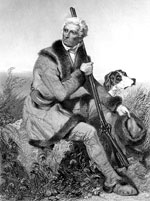Music Suited to a Lady
Jane Hanson, a music interpreter at Colonial Williamsburg, describes 17th-century musical instruments and colonial views on music and musicianship.
Jane Hanson, a music interpreter at Colonial Williamsburg, describes 17th-century musical instruments and colonial views on music and musicianship.
Lance Pedigo, drum major of Fifes and Drums at Colonial Williamsburg, discusses preparations for the fourth annual weekend of "Drummer's Call," as well as the use of the fife and drum during the American Revolution.
Relating the daily lives of America's ancestors is the product of research and performance. Performer Kat Getward shares the part that music plays in the Electronic Field Trip "Making History Live."
Scholars in Action presents case studies that demonstrate how scholars interpret different kinds of historical evidence. "Two White Horses Standin' in Line" (sung by Smith Cason) and "Worry Blues" (sung by Jesse Lockett), both recorded in 1939 by folklorist Alan Lomax, are known as "blues" songs.
The blues emerged as a musical form among African Americans in the late 19th and early 20th centuries and gained the attention of folklorists and record companies. Historians have studied blues and other African American musical forms to gain insight into the experiences and perspectives of poor and working-class African Americans who left few written records about their lives.
In a modest walk-up flat at 2658A Delmar Boulevard, Scott Joplin and his new bride Belle began their life in St. Louis. It was then called Morgan Street, a busy, densely populated, blue-collar district of African Americans and German immigrants. Located nearby were the honky-tonks and dives of the notorious Chestnut Valley. This black musical genius, buoyed by his success with the Maple Leaf Rag, was making his move toward the national arena. He would soon be known as the "King of Ragtime." Lit by gaslight, and appropriately furnished for 1902, the Joplin flat where many ragtime classics were composed awaits visitors. The building also has museum exhibits interpreting Joplin's life and work, and St. Louis during the ragtime era. The new Rosebud Cafe, a reconstructed structure that recreates a local turn-of-the-century bar and gaming club, is available to rent for gatherings.
The site offers exhibits, tours, and occasional recreational and educational events.

These historical materials come from 15 Kentucky colleges, universities, libraries, and historical societies. There are nearly 8,000 photographs; 95 full-text books, manuscripts, and journals from 1784 to 1971; 94 oral histories; 78 issues of Mountain Life and Work from 1925-62; and 22 issues of Works Progress Administration in Kentucky: Narrative Reports.
Photographs include collections by Russell Lee, who documented health conditions resulting from coal industry practices; Roy Stryker, head of the New Deal Farm Security Administration photographic section; and others that provide images of cities, towns, schools, camps, and disappearing cultures. Oral histories address Supreme Court Justice Stanley F. Reed, Senator John Sherman Cooper, the Frontier Nursing Service, veterans, fiddlers, and the transition from farming to an industrial economy. Texts include Civil War diaries, religious tracts, speeches, correspondence, and scrapbooks. Documents cover a range of topics, including colonization societies, civil rights, education, railroads, feuding, the Kentucky Derby, Daniel Boone, and a personal recollection of Abraham Lincoln.
Historians Monica Smith and Will Eastman outline the invention and development of the electric guitar in the 20th century.
The Country Music Hall of Fame and Museum presents the history of country music through its permanent exhibit, "Sing Me Back Home," showcasing both the music and the artifacts behind and surrounding it—costumes, lyrics sheets, musical instruments. It also hosts traveling and changing exhibits and programs and performances.
The museum offers exhibits, tours and in-museum workshops for school groups, curriculum guides, and educational and recreational events.
In 1943, Louis Armstrong and his wife, Lucille, settled in a modest house in Corona, Queens, where they lived for the remainder of their lives. Today, the furnishings and the house are preserved very much as they were during the Armstrongs’ lifetime.
Today, visitors are offered guided 40-minute tours, as well as occasional special events. Group tours (8 or more) must be scheduled in advance. The museum also holds several collections of artifacts that are available to researchers by appointment. The website offers visitor information, information regarding upcoming events and current exhibits, and a biography of Louis Armstrong. In order to contact the house via email, use the "contact" link located under the "about us" tab.
The B.B. King Museum and Delta Interpretive Center will take visitors back to the place where B.B. King grew up and lived the blues long before he learned to make the music that would change his life. Proposed educational, cultural, and character development programming will take the form of classes, mentoring, and interactive exhibits. In addition, the stories of the Delta, from its history to its music, social mores, race relations, literature and legends, and adversities and successes will be examined in one interpretive setting.
Please note: The museum will open Sept. 13, 2008.
The museum will offer exhibits, tours, and educational and recreational events and programs.